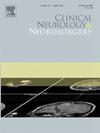Association of serum glucose/potassium index levels with poor long-term prognosis in patients with Aneurysmal Subarachnoid Hemorrhage
IF 1.8
4区 医学
Q3 CLINICAL NEUROLOGY
引用次数: 0
Abstract
Introduction
The glucose/potassium index (GPI) has been reported as a predictor biomarker of in-hospital complications in patients with aneurysmal subarachnoid hemorrhage (aSAH).
Objectives
To determine the association between GPI and functional outcome at 3 to 6 months after discharge in patients diagnosed with aSAH in a Peruvian referral hospital during 2018 - 2021.
Materials and Methods
We conducted a retrospective cohort observational study with a secondary database in patients with aSAH during 2018-2021 in a Peruvian referral hospital. We evaluated the relationship between GPI values and motor functionality from 3 to 6 months post-discharge, using a Poisson family generalized linear model with Log link function and robust variance according to categorization of good and poor outcome. We considered a value of p<0.05 as statistically significant. We used restricted cubic splines with five nodes to evaluate the linear correlation between the 2 main variables.
Results
212 patients were included in the analysis. 21.1% and 19.3% had poor outcome at 3 and 6 months after discharge, respectively. Multivariate analysis showed that GPI was not associated with poor outcome at 3 (RR=0.999; 95%CI=0.979-1.018) or 6 months after discharge (RR=0.979; 95%CI=0.979-1.020). On the other hand, Splines plots showed no correlation between GPI and modified Rankin.
Conclusions
Despite the usefulness of GPI to prognosticate in-hospital complications, its association with functional outcome is inconclusive.
动脉瘤性蛛网膜下腔出血患者血清葡萄糖/钾指数水平与长期预后不良的关系。
简介据报道,葡萄糖/钾指数(GPI)是动脉瘤性蛛网膜下腔出血(aSAH)患者院内并发症的预测生物标志物:目的:确定2018-2021年期间在秘鲁一家转诊医院确诊的动脉瘤性蛛网膜下腔出血患者出院后3-6个月GPI与功能预后之间的关联:我们利用二级数据库对秘鲁一家转诊医院 2018-2021 年期间的 aSAH 患者进行了一项回顾性队列观察研究。我们评估了 GPI 值与出院后 3 米至 6 个月的运动功能之间的关系,根据良好和不良结果的分类,使用了具有对数链接函数和稳健方差的泊松族广义线性模型。结果:212 名患者被纳入分析。在出院后 3 个月和 6 个月,分别有 21.1% 和 19.3% 的患者预后不佳。多变量分析显示,GPI 与出院后 3 个月(RR=0.999;95 %CI=0.979-1.018)或 6 个月(RR=0.979;95 %CI=0.979-1.020)的不良预后无关。另一方面,Splines 图显示 GPI 与修改后的 Rankin 之间没有相关性:结论:尽管 GPI 对预后院内并发症很有用,但其与功能预后的关系尚无定论。
本文章由计算机程序翻译,如有差异,请以英文原文为准。
求助全文
约1分钟内获得全文
求助全文
来源期刊

Clinical Neurology and Neurosurgery
医学-临床神经学
CiteScore
3.70
自引率
5.30%
发文量
358
审稿时长
46 days
期刊介绍:
Clinical Neurology and Neurosurgery is devoted to publishing papers and reports on the clinical aspects of neurology and neurosurgery. It is an international forum for papers of high scientific standard that are of interest to Neurologists and Neurosurgeons world-wide.
 求助内容:
求助内容: 应助结果提醒方式:
应助结果提醒方式:


